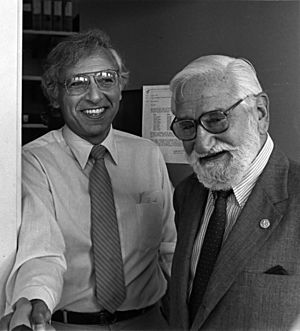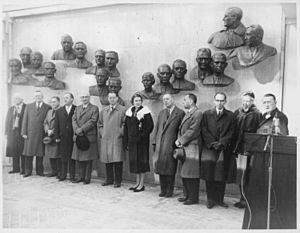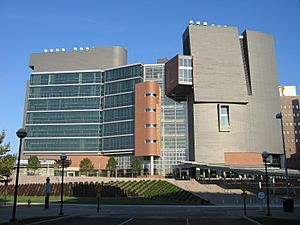Albert Sabin facts for kids
Quick facts for kids
Albert Sabin
|
|
|---|---|
 |
|
| Born |
Abram Saperstejn
August 26, 1906 |
| Died | March 3, 1993 (aged 86) Washington, D.C., U.S.
|
| Citizenship | Poland (until 1930), United States (since 1930) |
| Alma mater | New York University |
| Known for | Oral polio vaccine |
| Spouse(s) |
Sylvia Tregillus
(m. 1935; died 1966)Jane Warner
(m. 1967; div. 1971)Heloisa Dunshee de Abranches
(m. 1972) |
| Awards | E. Mead Johnson Award (1941) National Medal of Science (1970) John Howland Award (1974) Presidential Medal of Freedom (1986) |
| Scientific career | |
| Fields | Immunology, virology |
Albert Bruce Sabin (/ˈseɪbɪn/ SAY-bin; August 26, 1906 – March 3, 1993) was a Polish-American medical researcher. He is best known for creating the oral polio vaccine. This vaccine helped greatly in almost completely getting rid of the disease polio around the world. From 1969 to 1972, he was the president of the Weizmann Institute of Science in Israel.
Contents
Albert Sabin's Life Story
Abram Saperstejn, who later became Albert Sabin, was born in Białystok, which was then part of the Russian Empire. His parents were Polish-Jewish. In 1921, his family moved to the United States on a ship called the SS Lapland.
In 1930, he became a citizen of the United States. He changed his name to Albert Bruce Sabin. He finished high school in Paterson, New Jersey.
Sabin first started studying dentistry at university. But he became very interested in virology, which is the study of viruses. So, he changed his major. He earned a science degree in 1928 and a medical degree in 1931 from New York University.
Later in his life, in 1983, Sabin had a health problem that caused him a lot of pain and paralysis. He said this experience made him want to spend his life helping others with pain. He had successful surgery in 1992 when he was 86 years old. Albert Sabin passed away a year later in Washington, D.C., from heart failure.
His Medical Career
From 1931 to 1933, Sabin trained in different areas of medicine at Bellevue Hospital in New York City. In 1934, he did research in England. Then, he joined the Rockefeller Institute for Medical Research. During this time, he became very interested in studying infectious diseases.
In 1939, he moved to Cincinnati Children's Hospital in Cincinnati, Ohio. During World War II, he worked for the U.S. Army Medical Corps. He helped create a vaccine to fight Japanese encephalitis, a serious brain infection. By 1946, he was also leading Pediatric Research at the University of Cincinnati.
From 1969 to 1972, Sabin lived in Israel. He served as the president of the Weizmann Institute of Science. After returning to the United States, he continued his research work. He worked as a research professor at the Medical University of South Carolina from 1974 to 1982. Later, he moved to Washington, D.C., and worked at the John E. Fogarty International Center on the NIH campus.
Polio Research
Polio was a very scary disease that could cause paralysis. Albert Sabin and other scientists, like Jonas Salk, worked hard to find a vaccine. It was tricky because there were three main types of the poliovirus.
Jonas Salk developed an injected polio vaccine in 1955. This vaccine used a "dead" virus. It was good at stopping most of the serious problems from polio. However, it did not stop the virus from infecting the intestines first.
Sabin studied polio victims and found that the poliovirus first grew in the intestines. Then it moved to the nervous system. This discovery helped other scientists, John Enders, Thomas Weller, and Frederick Robbins. They successfully grew the poliovirus in lab dishes using non-nerve tissue in 1949. This important step earned them a Nobel Prize in Physiology or Medicine in 1954.
Sabin then created an oral vaccine. This vaccine used a weakened, "live" version of the poliovirus. It helped the body make antibodies without causing paralysis. Sabin even tested the vaccine on himself, his family, and his colleagues. His first official tests were in Ohio in 1954.
From 1956 to 1960, Sabin worked with Russian scientists to make his oral vaccine even better. They proved it was very effective and safe. Sabin's vaccine worked in the intestines. This stopped the poliovirus from getting into the bloodstream.
Between 1955 and 1961, over 100 million people received the oral vaccine. This happened in places like the USSR, Eastern Europe, and Mexico. A Soviet scientist named Mikhail Chumakov helped produce the vaccine on a large scale. This led to big trials in the United States in 1960. About 180,000 schoolchildren in Cincinnati received the vaccine. These mass vaccinations helped get rid of polio in Cincinnati.
Even though some groups supported Salk's vaccine, Sabin convinced the Public Health Service to approve his vaccine. His first oral polio vaccine was approved in the U.S. in 1961. Vaccines for the other two types of poliovirus were approved in 1962. At first, people took the vaccines on a sugar cube. In 1964, a single vaccine with all three types was approved.
Sabin's oral vaccine was easier to give than Salk's injected one. Its protection also lasted longer. For the next 30 years, Sabin's vaccine was the main way people were vaccinated against polio in the U.S. It stopped the virus from spreading. This made it possible to think that polio could one day be completely gone.
Sabin also worked on vaccines for other viral diseases. These included encephalitis and dengue. He also looked into possible links between viruses and some types of cancer.
Giving Back to the World
Sabin chose not to patent his vaccine. This meant that drug companies could not make a lot of money from it. He wanted the vaccine to be cheap so that more people could get it. Sabin never earned any money from his vaccine. He continued to live on his salary as a professor.
The Sabin Vaccine Institute was started in 1993 to continue his work. This institute helps develop and promote vaccines. Every year, it gives out the Albert B. Sabin Gold Medal. This award honors people who have done important work in the field of vaccinology.
Awards and Recognition
- In 1986, the president of the USSR gave Sabin the Order of Friendship of Peoples medal. This was for his oral vaccine that helped fight all three types of poliovirus.
- He was chosen for the Polio Hall of Fame in 1958.
- He received the Howard Taylor Ricketts Prize in 1959.
- He received the Robert Koch Prize in 1962.
- He received the Feltrinelli Prize in 1964.
- He received the Lasker-DeBakey Clinical Medical Research Award in 1965.
- He was given the National Medal of Science in 1970.
- He received the Medal of Liberty in 1986.
- He was awarded the Presidential Medal of Freedom in 1986.
- The Cincinnati Convention Center was named after Sabin from 1985 to 2006.
- In 1999, Cincinnati Children's Hospital Medical Center named its new education center after Sabin.
- The street between the University of Cincinnati College of Medicine and Cincinnati Children's Hospital was renamed Albert Sabin Way in 2000.
- In 2006, the U.S. Postal Service put his image on an 87-cent postage stamp.
- In 2012, Albert Sabin was named a "Great Ohioan" by the Capitol Square Foundation.
See Also
 In Spanish: Albert Sabin para niños
In Spanish: Albert Sabin para niños
- List of Poles




